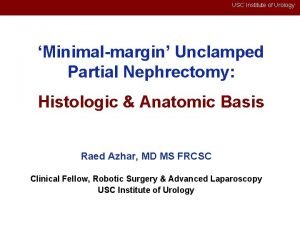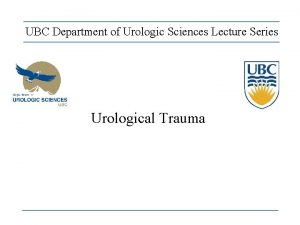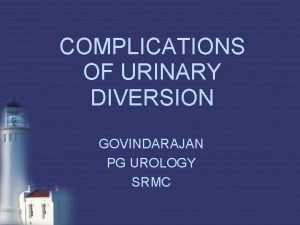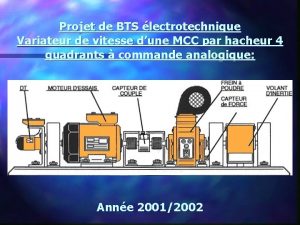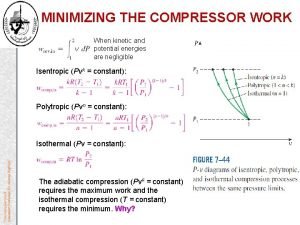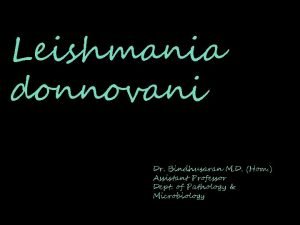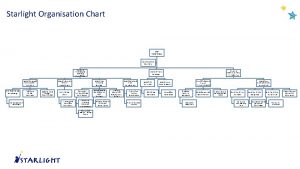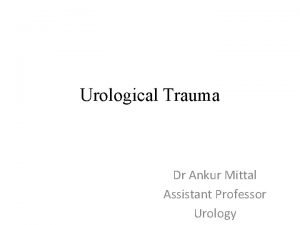Urological Trauma Dr Ankur Mittal Assistant Professor Urology






















































- Slides: 54

Urological Trauma Dr Ankur Mittal Assistant Professor Urology

Trauma: 1. Given a patient with a potential urinary tract injury: 1. 2. 3. 4. To list and interpret key clinical findings To list and interpret critical investigations Construct an initial management plan To list and specify previous genitourinary anomaly. • • • Renal Bladder Urethra Ureter External Genitalia Systems:

Renal Trauma Overview • Most commonly injured GU organ • 10% of all serious injuries abdominal have associated renal injury • Mode of injury – Blunt renal truma • MVA, fall from height, assaults – Penetrating renal injuries • Gunshots and stab wounds.

Hematuria and Renal Injury • Best indicator of significant injury(microscopic or gross) • NOT related to the degree of injury • Gross Hematuria is Variable and absent in : – 7 % of grade IV renal injury – 36% of renal vascular injury – 50% of UPJ injuries

Whom to work up • Penetrating trauma: EVERYONE • Pediatric patients with microscopic hematuria. • Blunt trauma: Image with CT if: • gross hematuria • microhematuria plus shock • microhematuria plus acceleration/deceleration Mee et al. (1989) Hardeman et al (1987

Imaging of trauma patient with hematuria • CT preferred – With contrast – With “delayed” films (mandatory) – Why not get CT cystogram too? • Standard intravenous pyelogram (IVP): Forget it • “One Shot” intraoperative IVP – 2 cc/kg intravenous contrast – Single film at 10 minutes

Intraoperative One Shot IVP • Allows safe avoidance of renal exploration in 32% (Morey et al, 1999) • Highly specific for urinary extravasation • Confirms existence of the other kidney

AAST Organ Injury Severity Scale for the Kidney

AAST Organ Injury Severity Scale for the Kidney

Indications for renal trauma surgery • Absolute – Hemodynamic instablity with shock – Expanding /pulsatile renal hematoma – Suspected renal pedicle avulsion (grade V) – UPJ disruption • Relative (now rare) – Urinary extravasation with non viable tissue – Renal injury together with colon /pancreatic injury – Delayed diagnosis of arterial injury

Indications for angiography with embolisation • • • Bleeding from renal segmental artery Unstable condition with grade III or IV AV fistula or pseudoaneurysm Persistent gross hematuria Blood loss extending 2 units in 24 hrs.

Management Options For Renal Trauma • Close observation – Bed rest – Serial Hemoglobins – Antibiotics if urinary extravasation • Radiographic Embolization • Urinary Diversion – Ureteral Stenting – Nephrostomy Drainage • Surgery – Renal Preservation / Reconstruction – Nephrectomy

Surgical considerations • Midline transabdominal approach • Early vascular control before opening gerotas fascia • Landmark is IMA or in presense of large hematoma , IMV.

Renal trauma in pediatric population • • Kidneys propotinally larger and less protected Less retroperitoneal and peritoneal fat Less musculature Higher sympathetic tone ie hypotention less reliable predictor of severity of renal injury.

Follow up • Repeat CECT within 72 hrs • Once pt is off hematuria and ambulatory , discharged • Adviced to avoid strenous activity for 4 -6 weeks • Follow up in opd after 3 weeks with USG and Hgm.

Bladder Trauma

Bladder: BLUNT: Overview • • Rarely isolated 80 -90 % have severe associated injuries Often high-energy injuries Associated with urethral rupture 10 -29% and pelvic fracture 6 -10%

Bladder: PENETRATING: Overview • • • Incidence 2% Associated major abdominal injuries (35%) and shock (22%) Mortality high: 12%

Bladder: Diagnosis: Physical Signs • • Suspicion: required in cases of penetrating trauma, based on trajectory Physical signs: – – – Abdominal pain Abdominal tenderness Abdominal bruising Urethral catheter does not return urine(gross hematuria in almost all cases) Delayed? • • Fever No urine output Peritoneal signs BUN / Creatinine

Bladder: Diagnosis: Hematuria • • Most (95%) have gross hematuria Microhematuria does occur: usually with minimal injury

Indications of imaging • Absolute – Gross hematuria with pelvic fracture(30 % with bladder rupture) – Penetrating injury of lower abdomen with any degree of hematuria • Relative – Gross hematuria without pelvic fracture – Microscopic hematuria with pelvic fracture

Bladder: Diagnosis Plain Cystography • Nearly 100% accurate when done properly: – – • • Adequate filling with 350 cc Drainage films Use 30% contrast Underfilling (250 cc) associated with false negatives

Bladder: Diagnosis CT Cystography • • • Preferred, especially if already getting other CTs Antegrade filling by “clamping the Foley” is not OK! Must dilute contrast (6: 1 with saline, or to about 2 -4%)

Bladder: Diagnosis CT Cystography Extraperitoneal Intraperitoneal

Management (extraperitoneal bladder rupture) • Uncomplicated cases: conservative management with catheter drainage. • Large bore (22 fr ) should be used. • Catheter removal 2 weeks after cystogram • Complications reported with conservative management (12% vs 5% with open repair) like fistula , clot retntion and sepsis.

Management (intraperitoneal bladder rupture) • All penetrating and intraperitoneal injuries should be managed with immediate open repair. • Catheter removal 1 week after cystogram.


Ureteral Injury • No reliable Physical findings! Usually a retrograde diagnosis • Non specific symptoms – Flank pain (36%-90%) – Fever – Ileus – Abdominal distension – fistula

Etiology • External trauma – High speed blunt injuries – Penetrating trauma • Surgical injury – Gynecological – Obstetric – General surgery( colorectal sx) – Urologic procedures • Ureteroscopic injury



Diagnosis • Presense of hematuria(non specific) • Imaging – IVU – CT urogram – RGP – Antegrade ureterography • Intraoperative recognisation

Hematuria and ureteral injury • Nonspecific indicator • 25 – 45% patients donot demonstrate even microscopic hematuria. • Being suspicious for it is the only way you will catch it.


Management




Posterior Urethral Injuries

Posterior Urethra Trauma: Etiology • • • 4 -14% of pelvic fractures Bilateral pubic rami fractures (straddle fracture) and sacroiliac diasthasis Mostly males, but can happen in females Associated bladder rupture in 10 -17% Rectal injury can lead to urethral-rectal fistula in 8%

Posterior Urethra Trauma: Diagnosis • • • Blood at meatus: 50% Inability to urinate Palpable full bladder Inability to place urethral catheter High riding prostate : 34% Rarely, perineal hematoma (late finding)

• Rarely females develop proximal urethral injury • Presents with vulvar edema and blood at vaginal introitus

Retrograde Urethrogram

Management • Immediate open reconstruction(curently no role) • Suprapubic cystostomy • Primary realignment • Delayed reconstruction – Endoscopic treatment – Surgical reconstruction

Anterior urethral injury • • Are often isolated Majority after stradle injury Involve bulbar urethra Presents with blood at meatus, perenial hematoma, gross hematuria n urinary retention


Complications • Erectile dysfunction – 50% – Cavernosal nerve injury – Arterial insufficiency – Venous leak – Direct corporal injury • Recurent stenosis(5 -15%) • Incontinence after reconstruction <4%

QUIZ (Grades of Renal Injuries)






Thanks
 Ankur taly
Ankur taly Dr ankur sinha
Dr ankur sinha Promotion from assistant to associate professor
Promotion from assistant to associate professor Cuhk salary scale 2020
Cuhk salary scale 2020 Leena mittal
Leena mittal Madhukar mittal
Madhukar mittal 4 types of trust
4 types of trust Lga to pie
Lga to pie Lahey's method of thyroid examination
Lahey's method of thyroid examination Arcelor mittal net
Arcelor mittal net Rowena mittal
Rowena mittal Prateek mittal
Prateek mittal Ipo readiness deloitte
Ipo readiness deloitte Rajat mittal
Rajat mittal Mentimetre
Mentimetre Hypoaldosteronism
Hypoaldosteronism Urology
Urology Dr donaldson urology
Dr donaldson urology Urology coding cheat sheet
Urology coding cheat sheet Rpug in urology
Rpug in urology Congenital adrenal hyperplasia genitalia
Congenital adrenal hyperplasia genitalia Laura oakley
Laura oakley Ubc urology
Ubc urology Children urology
Children urology Refhelp urology
Refhelp urology Urology match
Urology match Srmc urology
Srmc urology Hidrocele y varicocele
Hidrocele y varicocele Pediatric urology salary
Pediatric urology salary Urology match
Urology match Office management assistant psc
Office management assistant psc Assistant secretary for aging
Assistant secretary for aging Hacheur assistant
Hacheur assistant Bakersfield adult school
Bakersfield adult school Palliative care assistant
Palliative care assistant Isentropic efficiency for a compressor
Isentropic efficiency for a compressor Assistant district commissioner scouts
Assistant district commissioner scouts Junior assistant scoutmaster
Junior assistant scoutmaster Anwser
Anwser Leishmanioma
Leishmanioma Kpu health care assistant
Kpu health care assistant Mon assistant visuel sncf
Mon assistant visuel sncf What are writing conventions
What are writing conventions Smart middle school
Smart middle school Dialogue shop assistant and customer
Dialogue shop assistant and customer Starlight assistant
Starlight assistant Patient safety assistant
Patient safety assistant Akshay kumar assistant
Akshay kumar assistant Varicocele grading radiology assistant
Varicocele grading radiology assistant University of new england physician assistant program
University of new england physician assistant program Signmaker's assistant
Signmaker's assistant Cyp assistant director
Cyp assistant director Student loginusernamepassword
Student loginusernamepassword Hikvision recording assistant
Hikvision recording assistant The signmaker's assistant vocabulary
The signmaker's assistant vocabulary
















